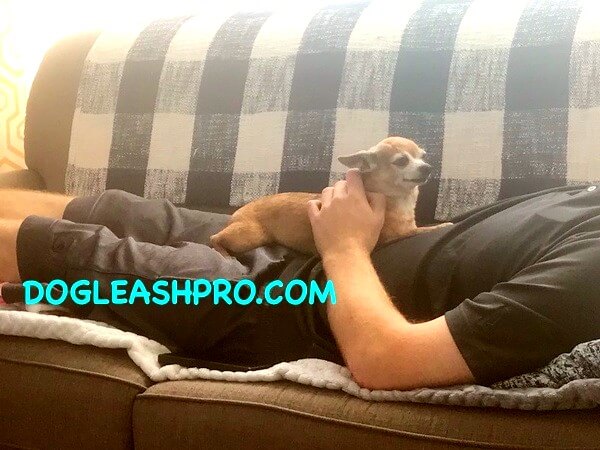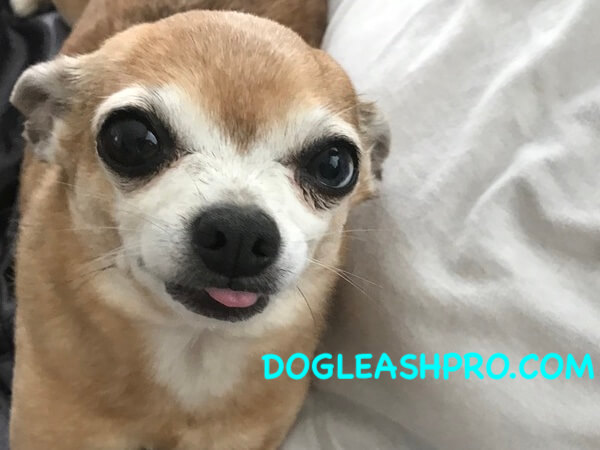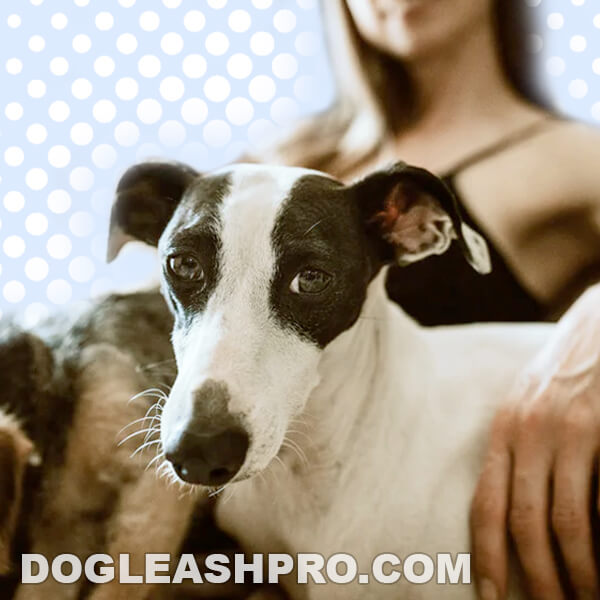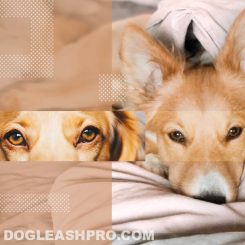
You often find your dog laying on you or sleeping on top of you with their eyes open and you’re wondering why do dogs lay on you and what does it mean when a dog lays on you. If you’re interested in finding out why does my dog always want to lay on me or why does my dog likes to sleep on top of me, keep reading. In the meantime, here are the short answers.
Why does my dog always lay on me? Your dog always lay on you because he wants your attention or feels the need to protect you. When you’re lying down, your dog may lay on top of you as a way to guard you against threats because he thinks you’re in a vulnerable state. As a result, their protective instinct kicks in to protect you. If you continue to allow your dog to lay on top of you, you’re reinforcing this behavior and your dog thinks this is ok to do.
Why does my dog sleep on top of me? Your dog sleeps on top of you for various reasons. The first is to protect you. A canine’s sleep cycles are much shorter than human sleep cycles so they’re instinctively alert of their environment. They sleep on top of you to guard you even while they’re getting their sleep. Second, dogs find it very comfortable to sleep on top of you as your body heat provides them warmth. Third, they’re trying to show you affection.
Table of Contents
Why does my dog lay on top of me (and sleep on top of me)? 7 Reasons Why!

1. Your dog wants to protect you
In the canine world, being a part of the pack and protecting the pack is vital. Whether your dog is laying on top of you awake or sleeping on top of you, they remain very alert of their surrounding.
Your dog sees you as the alpha leader of the pack so he or she will want to protect you against potential threats. By laying on top of you, they feel more in control, and is a way they feel they are guarding you against any potential trouble.
It’s important to keep in mind that no two dogs are the same so some dogs are more protective than other dogs.
Here are three examples we would like to share that we found online:
Pug protecting the owner from a Great Dane
A Pug owner was sitting outside enjoying the summer breeze with his tiny Pug sleeping on his lap. A few minutes later, a giant dog, the Great Dane, tried to walk towards them. Immediately, the Pug woke up and without hesitation, jumped down from the owner’s lap. The small Pug lunged towards the Great Dane and growled and bark as loud as it could.
This shows us that while our dogs may appear to be sleeping, they are always alert to their surrounding. It’s as if they still know what’s going on even when they’re sleeping.
The Pug felt the need to protect its owner however way it could and one of the ways is to sleep on top of you whether on your lap or stomach to safeguard you from a potential threat.
Goldendoodle protecting its owner and other household dogs
There’s another instance of a dog owner who wrote on an online forum about his two dogs – a German Shepherd and a Goldendoodle.
We automatically assume that the German Shepherd is more protective of the owner than the Goldendoodle. But actually, the opposite was true.
In many cases, the Goldendoodle was the dog that protected the owner and even the German Shepherd. Interesting right? When the owner got into an argument with a neighbor, it was the Goldendoodle that came out and tried to protect the owner by attacking the neighbor.
Occasionally, the neighbor’s Husky would walk onto the owners’ front yard where the German Shepherd dog would lay relaxing on the grass. When the Goldendoodle dog saw this from inside the house, it came running out to protect the German Shepherd by attacking the Husky.
As we can see here, dogs protect their owners in different ways. One dog may show its protective nature by staring down at the threat until the threat backs down or away (like what the German Shepherd did) while the other dog may show its protective nature by attacking (what the Goldendoodle did).
One of your dogs is protective out of jealousy
If you have more than one dog at home, you may have already experienced a situation where one of your dogs may want to protect you from the other dogs or pets in the house.
If your dog sees another dog coming towards you, he may start barking and growling towards that dog because he feels jealous. Sometimes, he may even throw a tantrum to get your attention because he’s jealous you’re attending to your other dogs.
Here’s an example of this:
According to 2014 research, jealousy in domestic dogs does exist (see source). In this research study, there was a total of 36 dogs of different dog breeds.
The dog owners were told to ignore the dog and focus their attention on something else, whether it be a plastic jack-o-lantern, children’s book, or fake dog.
The result of the study proved that jealousy in dogs does exist. When the dogs saw their owners talking and petting the fake dog, they became very jealous.
Of the 36 dogs, 31 of them started to sniff the behind of the fake dog. This behavior suggests that the dog sees the fake dog as real and they are jealous that their owners are paying more attention to another dog instead of them.
However, when the owners paid the same amount of attention to the plastic jack-o-lantern and children’s book, the dog didn’t care.
This research paper reminded me of a recent video I saw of a Golden Retriever dog named Sadie. The owner talked to the stuffed dog toy and Sadie got pretty jealous! It will give you the laugh you need today:
2. Your dog feels comfortable and warm when laying on top of you

Your dog is laying on top of you because he finds it very comfortable and warm. Dogs love comfort. If you are lying down and your dog finds your tummy or leg comfortable, then without hesitation, he will be there. Even if it means laying on top of you.
I know my mom spends a lot of time with her Chihuahua so when she’s lying down on the sofa to watch tv, her little Chihuahua jumps up to the sofa and finds a comfortable spot on her belly.
When my mom came home from her recent one-week vacation, her Chihuahua, Lily, would climb on top of her and lay there on her belly for hours. Lily, the Chihuahua is trying to tell my mom that she misses her so much and doesn’t want to be separated from her again.
During the winter, our apple head Chihuahua would get cold very easily. While we provide her with plenty of warm blankets, she would still climb on top of my mom’s belly and sleep. Our Chihuahua finds my mom’s belly more comfortable than her own warm and cushy bed!
This is a common behavior in smaller dog breeds. Since small dog breeds like Chihuahuas love the warmth and have shorter coats or less hair, they may find your body heat to be comforting and warm. It may also appear as if you’re an inviting bed or pillow for your canine friends.
3. Dog owners allow their dogs to lay on top of them
Dogs also lay on top of you because they’ve done it once before and you were fine with it so they do it again and again.
For instance, coming home from work after a long day and eating a full meal, I would be exhausted. Instead of cleaning up the dishes, I would plop down on my sofa and turn on the tv.
In the midst of watching my favorite show, my Labrador puppy would jump onto the sofa and crawl on top of me, and lay on my chest. Without any second thought, I instinctively do the following:
- Pet her and rub her ears.
- Kiss the top of her head.
- Hug her tight.
- Cuddle with her.
Any and all of these actions let my puppy know that climbing on top of me and laying on top of my chest is ok. If I didn’t like this or isn’t ok with this, then I would motion my pup to leave.
However, since I’m comforting my pooch, it shows that I’m reinforcing this behavior and they can continue to lay on top of me.
This is why as dog owners, we need to be more aware of our reactions towards what our pups do. When our dogs lay on top of us and we are petting them, it’s like rewarding them for this behavior.
If you don’t like this behavior, you’ll want to stop them from doing this immediately so it doesn’t happen again.
4. Dogs lay on top of you to show you love and affection
Dogs are one of the most loyal companions and they love their owners very much. As a way of showing their love and affection, dogs will lay on top of you.
After being gone for a good chunk of the day, my Labrador puppy loves to interact with me. She would lay on top of me to get my attention so that I can reciprocate the love and affection back.
When the owner spends a lot of time with the dog, they both develop a strong, special, and close bond. When your dog lays on top of you and you allow her to do so, it further strengthens the bond between you two.
And when your dog is laying on top of you, they’re in a perfect position to give you a kiss or two or more! This is their way of showing you love and affection.
It doesn’t matter whether the dog is big or small. In fact, here is a video of a big Bernese Mountain dog named J.J. He stops by every morning to wake up his owner by laying on top of his owner’s body and giving many kisses. J.J. doesn’t know how big and heavy he is and his owner instructs him to get down from the bed:
Laying on top of you makes your dog very happy
Studies show that it makes the dogs very happy when they are laying on top of you. A research study shows that when owners stroke, touch, or pet their dog, both the dog and the owner releases a hormone called oxytocin, which makes both feel good and happy.
When your dog is laying on top of you, there’s also a higher chance of making eye contact. And oxytocin is released when you’re looking at your dog’s eyes. That’s why you often feel good when looking directly at your dog’s eyes.
Oxytocin is pretty powerful. It can also lower the glucocorticoid (stress hormone) levels in both dogs and humans.
Lastly, oxytocin prevents aggression and improves your social skills. When oxytocin is released in your body, it helps to lower depression and increase both face memory and eye contact.
You might also like: 35 Interesting Dog Facts
5. Dogs lay on top of you when they have separation anxiety
Many dog owners who have to leave home for an extended period of time due to work or other obligations often feel bad for leaving their pooch home alone.
It’s also difficult for dogs that suffer from separation anxiety.
According to a 2014 research paper, dogs have separation anxiety when the person they are attached to is not there with them. When their owners are not there with them, they become anxious and are unable to cope well.
In fact, dogs suffering from separation anxiety may cope by becoming destructive which includes destroying, chewing, or scratching furniture, barking loudly, whining, or even crying.
You might also like: Do Dogs Get Tired Of Barking?
Other signs of separation anxiety that are less obvious include:
- Depression.
- Licking his or her skin and coat excessively.
- Trying to escape the house.
- Pooping and peeing inside the house.
- Trembling uncontrollably.
- Salivation.
- Pacing around in a circle.
As soon as the owner leaves the house, the dog’s separation anxiety immediately increases.
When the owner returns home, the dog will be very excited to see the owner and when he gets a chance, he will lay on top of you to show how excited they are to see you again.
If you are concerned about your dog’s separation anxiety, consult with your vet to see if there’s anything you can do to help. Additionally, you can hire a dog sitter or bring your pooch to a nearby doggy daycare.
6. Dogs lay on top of you because they want your attention
Like humans, dogs also want attention. This is common in puppies because they’re trying to get their mom’s attention in order to survive. But sometimes the attention-seeking behavior can be a bit too much to handle and quite annoying.
Some dogs will resort to bad behavior to get their owners’ attention. These bad behaviors include:
- Climbing on top of you and laying on top of you.
- Putting their head and face next to yours.
- Barking.
- Scratching or chewing surfaces.
- Pawing at the owner’s face or hand.
- Frequent licking.
- Nipping at the owners’ heel or feet.
- Poking.
- Stealing food from the trash.
- Clinging.
- Restlessness.
Here is Cookie, the Labrador that ended up laying on top of his owner to get the owner’s attention.
Here’s why dogs engage in attention-seeking behaviors
Like us, dogs are also very social. They like to interact with and seek their human owners’ attention every day.
Sometimes, owners don’t realize that they are encouraging their dogs’ bad behaviors. I caught myself doing this when my Chihuahua dog would paw at my legs to get my attention and I would reach down and carry her on my arms.
Dogs often seek attention when they feel bored. Dogs that are bored may lack the following:
- Lack of physical and mental stimulation.
- Lack confidence.
- Feeling fearful.
7. Your dog wants to tell you something
Lastly, we all know that dogs are unable to communicate with us verbally. Instead, they communicate their wants and needs with us in other ways.
Laying on top of you is one such way. Although it may seem like your dog is laying on top of you because he is trying to be close to you, there could be other reasons too.
For example, the dog may lay on top of you to tell you that he wants to play with you. He may lay on top of you to ask you to get him a dog bone. If the dog is hungry or there’s no water in the water bowl, he may lay on top of you to get your attention.
Sometimes your dog needs to go out to potty and the only way to get your attention and tell you he needs to head out is by laying on top of you.
DISCLAIMER: THIS WEBSITE DOES NOT PROVIDE MEDICAL ADVICE
The information, including but not limited to, text, graphics, images and other material contained on this website are for informational purposes only. No material on this site is intended to be a substitute for professional veterinary advice, diagnosis, or treatment. Always seek the advice of your veterinarian or other qualified health care provider with any questions you may have regarding a medical condition.

With over five years of specialized experience as an animal writer, my expertise lies in dog nutrition, health, behavior, grooming, and training. I am dedicated to delivering helpful and informative content that caters to the well-being of our furry friends. My primary goal is to empower pet owners with knowledge and ensure our canine companions thrive in health and happiness. In my free time, I love volunteering at local dog rescue centers.







